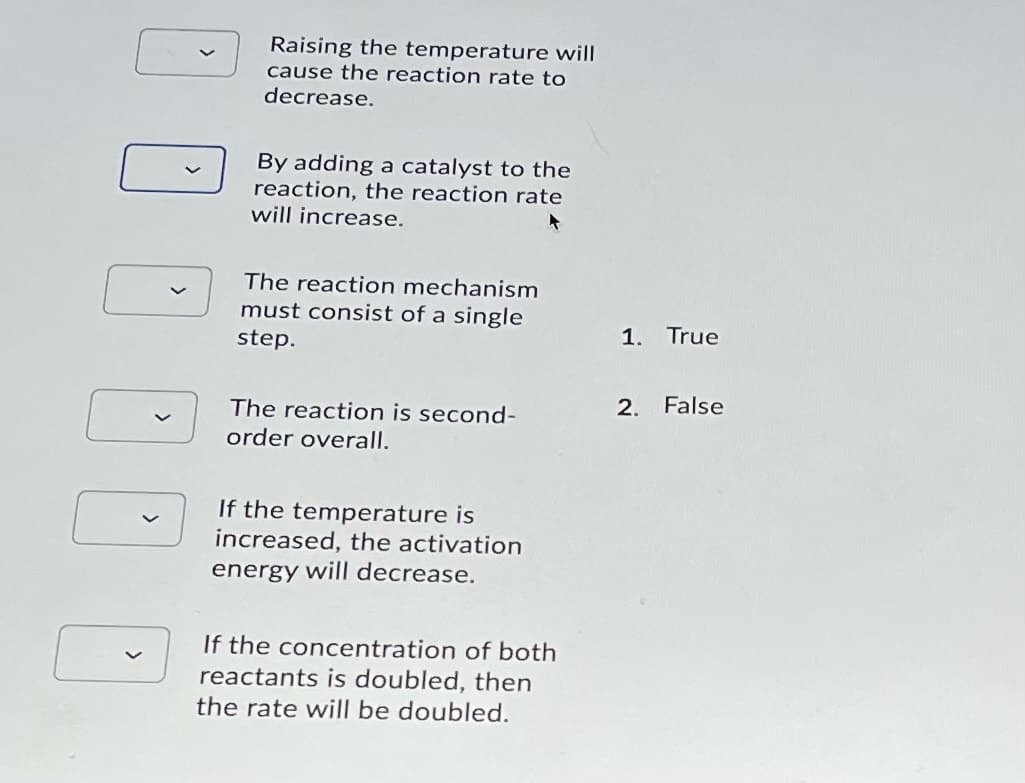Raising the temperature will cause the reaction rate to decrease. By adding a catalyst to the reaction, the reaction rate will increase. The reaction mechanism must consist of a single 1. True step. The reaction is second- 2. False order overall. If the temperature is increased, the activation energy will decrease. If the concentration of both reactants is doubled, then the rate will be doubled. >
Raising the temperature will cause the reaction rate to decrease. By adding a catalyst to the reaction, the reaction rate will increase. The reaction mechanism must consist of a single 1. True step. The reaction is second- 2. False order overall. If the temperature is increased, the activation energy will decrease. If the concentration of both reactants is doubled, then the rate will be doubled. >
Chemistry: The Molecular Science
5th Edition
ISBN:9781285199047
Author:John W. Moore, Conrad L. Stanitski
Publisher:John W. Moore, Conrad L. Stanitski
Chapter11: Chemical Kinetics: Rates Of Reactions
Section: Chapter Questions
Problem 31QRT
Related questions
Question

Transcribed Image Text:Raising the temperature will
cause the reaction rate to
decrease.
By adding a catalyst to the
reaction, the reaction rate
will increase.
The reaction mechanism
must consist of a single
step.
1.
True
2. False
The reaction is second-
order overall.
If the temperature is
increased, the activation
energy will decrease.
If the concentration of both
reactants is doubled, then
the rate will be doubled.
![Consider the gas-phase reaction to form hydrogen iodide, HI. The rate law has been
determined experimentally to be Rate = k [H2] [I2].
H2(g) + I2(g) → 2 HI(g)
Identify each statement as being either true or false.](/v2/_next/image?url=https%3A%2F%2Fcontent.bartleby.com%2Fqna-images%2Fquestion%2Fe1e2bf7c-a455-4be8-b420-47e3d58edab9%2F09c4bc86-7809-408c-8c6e-69e755d0829b%2Fqaffwhn_processed.jpeg&w=3840&q=75)
Transcribed Image Text:Consider the gas-phase reaction to form hydrogen iodide, HI. The rate law has been
determined experimentally to be Rate = k [H2] [I2].
H2(g) + I2(g) → 2 HI(g)
Identify each statement as being either true or false.
Expert Solution
This question has been solved!
Explore an expertly crafted, step-by-step solution for a thorough understanding of key concepts.
Step by step
Solved in 2 steps with 2 images

Knowledge Booster
Learn more about
Need a deep-dive on the concept behind this application? Look no further. Learn more about this topic, chemistry and related others by exploring similar questions and additional content below.Recommended textbooks for you

Chemistry: The Molecular Science
Chemistry
ISBN:
9781285199047
Author:
John W. Moore, Conrad L. Stanitski
Publisher:
Cengage Learning

General Chemistry - Standalone book (MindTap Cour…
Chemistry
ISBN:
9781305580343
Author:
Steven D. Gammon, Ebbing, Darrell Ebbing, Steven D., Darrell; Gammon, Darrell Ebbing; Steven D. Gammon, Darrell D.; Gammon, Ebbing; Steven D. Gammon; Darrell
Publisher:
Cengage Learning

Chemistry & Chemical Reactivity
Chemistry
ISBN:
9781337399074
Author:
John C. Kotz, Paul M. Treichel, John Townsend, David Treichel
Publisher:
Cengage Learning

Chemistry: The Molecular Science
Chemistry
ISBN:
9781285199047
Author:
John W. Moore, Conrad L. Stanitski
Publisher:
Cengage Learning

General Chemistry - Standalone book (MindTap Cour…
Chemistry
ISBN:
9781305580343
Author:
Steven D. Gammon, Ebbing, Darrell Ebbing, Steven D., Darrell; Gammon, Darrell Ebbing; Steven D. Gammon, Darrell D.; Gammon, Ebbing; Steven D. Gammon; Darrell
Publisher:
Cengage Learning

Chemistry & Chemical Reactivity
Chemistry
ISBN:
9781337399074
Author:
John C. Kotz, Paul M. Treichel, John Townsend, David Treichel
Publisher:
Cengage Learning

Chemistry: Matter and Change
Chemistry
ISBN:
9780078746376
Author:
Dinah Zike, Laurel Dingrando, Nicholas Hainen, Cheryl Wistrom
Publisher:
Glencoe/McGraw-Hill School Pub Co

Chemistry: Principles and Practice
Chemistry
ISBN:
9780534420123
Author:
Daniel L. Reger, Scott R. Goode, David W. Ball, Edward Mercer
Publisher:
Cengage Learning

Chemistry for Engineering Students
Chemistry
ISBN:
9781285199023
Author:
Lawrence S. Brown, Tom Holme
Publisher:
Cengage Learning